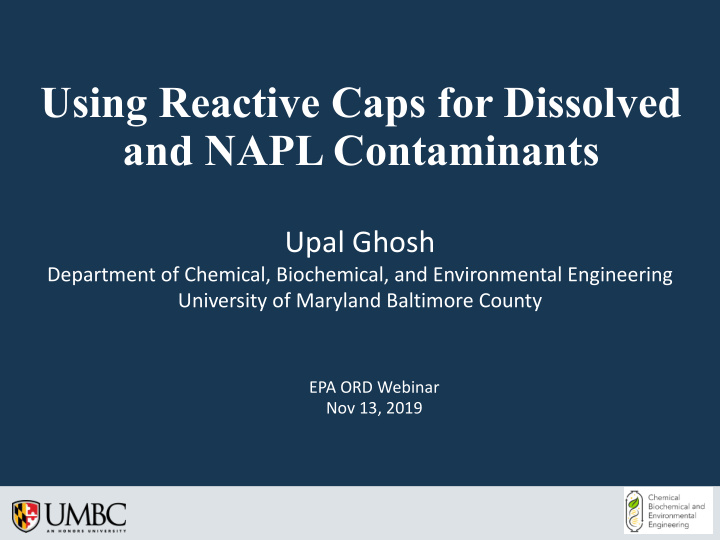



Using Reactive Caps for Dissolved and NAPL Contaminants Upal Ghosh Department of Chemical, Biochemical, and Environmental Engineering University of Maryland Baltimore County EPA ORD Webinar Nov 13, 2019
OUTLINE • Pollutant bioavailability in sediment • Strategies of engineering pollutant bioavailability • Pilot and full-scale demonstrations
PROBLEM: MANAGING EXPOSURE FROM HISTORIC DEPOSITS OF CONTAMINATED SEDIMENTS • Contaminated sediment sites are large • How do you clean up an ecologically sensitive site without destroying it? • Current technologies are expensive and disruptive • Need for innovative techniques that reduce risks • CAN WE ENGINEER SEDIMENT GEOCHEMISTRY TO ALTER BIOAVAILABILITY? 3
ORGANIC CARBON TYPE CONTROLS PARTITIONING • Sediment contains a range of inorganic, organic, coal and anthropogenic particles • Pollutants can be associated with various source char materials and carbon types • Hydrophobic pollutants associated with minerals, natural organic matter, and NAPL phase mostly wood mobile and bioavailable • Hydrophobic pollutants bound to black carbon sand particles less bioavailable shell charcoal soot coal charcoal coke NAPL From: Ghosh et al. Environ. Sci. Technol. 2003
STRONG SORPTION REDUCES PCB UPTAKE IN WORMS • Laboratory studies demonstrated reduction of PCB biouptake • Surface application is worked into sediments through bioturbation L. Plumulosus • Powdered AC works much better (2 nd generation, 60- than granular AC day exposure: 82% reduction) • Led to several pilot-scale demonstrations Zimmerman et al. ES&T 2003 Sun & Ghosh, ES&T 2007 5 Ghosh et al. ES&T 2011 Bailey Cr. Ft. Eustis, VA Pilot Study
CONCEPTUAL MODEL OF IN-SITU TREATMENT WITH AC AC amendment reduces exposure to food chain through: 1) Reduced bioaccumulation in benthic organisms 2) Reduced flux into water column and uptake in the pelagic food web. 3) In the long-term, the carbon amended layer is covered with clean sediment. 6
BROADENING THE CONCEPT OF TRADITIONAL CAPS Exposure control Two basic engineering approaches: • Altering the geochemistry of an existing surficial layer • Tailoring sand caps with sorbent amendments From Patmont, Ghosh et al. IEAM 2015
Would like to get feedback from audience How often do you incorporate concepts of pollutant bioavailability in your sediment assessment/remediation work? Always • Sometimes • Never •
KEY PUBLICATIONS: MOVING TECHNOLOGY FORWARD In-situ Sorbent Amendments: USE OF AMENDMENTS FOR IN-SITU A New Direction in Contaminated REMEDIATION OF SUPERFUND SEDIMENT SITES Sediment Management USEPA OSWER Directive 9200.2-128FS; April 2013 Several recent RODs have included AC amendment as a component of the proposed remedy 9
SEVERAL DEMONSTRATION PROJECTS San Francisco Bay, Grasse River, Trondheim Harbor, Grenlandsfjords, CA, USA, 2006 NY, USA, 2006 Norway, 2006 Norway, 2009 SLURRY INJECTION AND SLURRY INJECTION AND SLURRY INJECTION WITH ACTIVE CAP OF SITE CLAY ROTOTILLER . COVERED ROTOTILLER AND WITHOUT CLAY AND ACTIVATED CARBON MIXTURE Bailey Creek, Canal Creek, Berry’s Creek, Abraham’s Creek, VA, USA, 2009 MD, USA, 2010 NJ, USA, 2012 MD, USA, 2014 PELLETIZED CARBON PELLETIZED CARBON WITH PELLETIZED CARBON PELLETIZED CARBON DELIVERY (SEDIMITE) DEGRADERS DELIVERY (SEDIMITE) DELIVERY (SEDIMITE) DELIVERY (SEDIMITE)
PAH NAPL AT SOURCE AND MIGRATION THROUGH CAPS Measured and predicted PAH breakthrough in caps Dissolved PAHs in source sediments well predicted by a NAPL partitioning model Gidley et al. Environ. Sci. Technol. 2012, 46, 5032−5039
TECHNOLOGY TRANSITION : NEW PRODUCTS 1.AC works best in powdered form – difficult to apply directly 2.Agglomerates delivered from water surface 3.Sinks to sediment surface and resists resuspension 4.Breaks down slowly & mixed into sediment by bioturbation 5.Developed at UMBC in collaboration with Dr. Charlie Menzie - EPA SBIR 12
FULL-SCALE: RESTORATION & REMEDIATION OF A LAKE • Urban lake sediments impacted with PCBs and PAHs • Ecological restoration included removal of sand bar and creation of wetlands • In-situ treatment of surface sediments with AC to Optimum Dose reduce exposure. • Monitoring includes PCBs in porewater, surface water, benthic invertebrates, and fish. • In addition, ongoing inputs are being tracked. • Optimum dose of 3 – 5% met http://www.youtube.com/watch?v=l88oE6aTHK8&feature=youtu.be
PCB IN FISH TISSUE • Nearly 70% reduction in resident fish (brown bullhead and bluegill) • Resident fish PCB levels now below consumption advisory for DE • Less reductions in migratory white perch and blueback herring Patmont et al. ASCE J. Environ. Engr. 2019
IMPACT ON BENTHIC COMMUNITY • Very limited AC effects, mostly in lab setting at high doses Jansen and Beckingham 2013. Environ. Sci. Technol. 47:7595-7607
KEY MESSAGES • Pollutant bioavailability can be altered in-situ by altering sediment geochemistry • Two basic approaches: • Direct AC amendment to sediment • AC-amended sand cap • AC particle size a key factor for performance • Works in full-scale • Persistence and performance demonstrated long-term
Would like to get feedback from audience Do you have a site in mind that would benefit from exploring the use of an active cap or in-situ treatment as described in this presentation? Yes • No • What do you see as the most important barrier(s) for implementing in-situ amendment of AC?
ACKNOWLEDGEMENTS Students and post docs: Hilda Fadaei, Mandar Bokare, James Sanders, Barbara Beckingham, Trevor Needham, Nathalie Lombard Funding Sources: National Institutes of Health, US Dept of Defense, SERDP/ESTCP Programs; USEPA Great lakes National Program Office; Alcoa, USEPA SBIR program; DOEE, Alcoa, Dow Chemical Company Collaborators: Allen Place, IMET; Richard Greene and John Cargill, Delaware Dept of Natural Resources and Environmental Control; Brightfields Inc. Kevin Sowers; Richard Luthy, Stanford. Disclosure statement: Upal Ghosh is a co-inventor of two patents related to the technology described in this paper for which he is entitled to receive royalties. One invention was issued to Stanford University (US Patent # 7,101,115 B2), and the other to the University of Maryland Baltimore County (UMBC) (U.S. Patent No. 7,824,129). In addition, UG is a partner in a startup company (Sediment Solutions) that has licensed the technology from Stanford and UMBC and is transitioning the technology in the field. Ghosh research group at UMBC 18
Recommend
More recommend